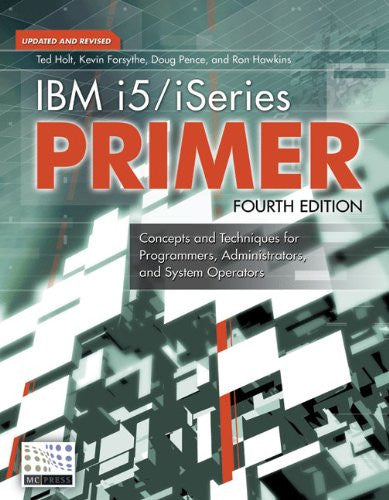One popular misconception I run into from time to time is that input and output specifications (I- and O-specs) cannot be used with externally described files in RPG programs. I- and O-specs can be used with externally described files, but they serve a different function from those used for traditional, RPG II- type, program described files. The difference is that the I- and O-specs of program described files define records; those of externally described files modify external record definitions. The following material explains how some programming tasks can be made easier by using I- and O-specs with externally described files.
Input Specifications
One of the features I most like about RPG is that the cycle takes care of control break processing. Call me lazy, but I believe that the programmer should do nothing the computer can do for him. So I was overjoyed to learn that I could still use the cycle to handle control breaks, even with externally described files. I'll explain the process, but first let me give you some background information.
When you are working with files, there are two types of I-specs in RPG-the record definition and the field definition. Program described, record definition I-specs require a file name, but I-specs that modify an external definition take a record name instead. The only other entry permitted is an optional record identifying indicator.
Field definition I-specs for externally described files have more in common with program described I-specs. With field definition I-specs for externally described files, you list only the fields in the record that you wish to modify. The unlisted fields will still be included by the compiler. You do not specify beginning positions, ending positions, or the data type; the compiler will retrieve that information from the external definition. You may specify control level indicators, match field codes, or field indicators, but not field record relation indicators.
One nice feature of the field definition I-spec for an externally described file is that it allows you to rename a field. If you don't want to use the field names in the external definition, assign other field names instead. (Prior to ILE RPG, if your external definition defines a field name greater than six characters, you're forced to rename the field.) To rename a field, code its external name in columns 21-30, and the name by which it will be known within the program, in columns 53-58.
To illustrate, let's consider a file of sales transactions. The file name is SALES. It has one record type, SALESREC. The fields are listed in 1. Look at the program fragment in 2. SALES is being read in key sequence by the RPG cycle. Indicator 01 turns on when a record of this type is read. The cycle will check for a control break on the transaction date field. The item number is called ITEM# in the external file definition, but in this program it is known as ITM. The other fields-XACT#, CUST#, QTY, and STATUS-will be used in the program without change.
To illustrate, let's consider a file of sales transactions. The file name is SALES. It has one record type, SALESREC. The fields are listed in Figure 1. Look at the program fragment in Figure 2. SALES is being read in key sequence by the RPG cycle. Indicator 01 turns on when a record of this type is read. The cycle will check for a control break on the transaction date field. The item number is called ITEM# in the external file definition, but in this program it is known as ITM. The other fields-XACT#, CUST#, QTY, and STATUS-will be used in the program without change.
Output Specifications
Like I-specs, O-specs come in record definition and field definition varieties. You can probably guess the first difference in record definition O-specs-the record name, rather than the file name, is coded in columns 7-14. Other differences are that the space, skip, and fetch overflow entries are not used with externally described printer files.
Field definition O-specs associated with externally described files differ slightly from those for program described files. With externally described files, you cannot specify ending positions or data types for the field, or use edit codes or edit words.
The most common use of field definition O-specs is to select the fields to output. In 3, the sales record is voided by placing a V in the status field. No other field in the record will be changed. If you want all fields to be written to the output file, use the special value *ALL as shown in 4. You'll only need one field definition O-spec, of course. At detail output time, the RPG cycle will write an entire record if indicator 01 is on and indicator 23 is off.
The most common use of field definition O-specs is to select the fields to output. In Figure 3, the sales record is voided by placing a V in the status field. No other field in the record will be changed. If you want all fields to be written to the output file, use the special value *ALL as shown in Figure 4. You'll only need one field definition O-spec, of course. At detail output time, the RPG cycle will write an entire record if indicator 01 is on and indicator 23 is off.
Two major differences exist between I- and O-specs for externally described files. First, you cannot rename fields in O-specs. Second, omitted fields in I- specs are included by the compiler, but omitted fields in O-specs are ignored. Differences in ILE RPG
Specifications
According to IBM, the format of I- and O-specs in the new Integrated Language Environment (ILE) RPG has been changed, but not the function. The new format essentially allows room for 10-character field names.
5 shows the differences between I-specs for RPG/400 and ILE RPG. 6 shows the differences between O-specs. Neither type of specification has changed much.
Figure 5 shows the differences between I-specs for RPG/400 and ILE RPG. Figure 6 shows the differences between O-specs. Neither type of specification has changed much.
Even though I have used RPG/400 to illustrate the techniques I have described, they will work with externally described files in ILE RPG except for the renaming of externally described fields. Since ILE RPG can accommodate 10- character field names, the external field name column is obsolete. For more information about I- and O-specs in ILE RPG, see "An Introduction to ILE RPG: Part 3," MC, May 1994.
Thoughts on Programming
Technique
Control-level indicators and the ability to update only certain fields in a record are advantages RPG has over other programming languages. Contrary to what many programmers have been led to believe, you do not have to give up these strengths of RPG when you use externally described files.
Ted Holt is an associate technical editor for Midrange Computing.
REFERENCES
ILE RPG/400 Reference (SC09-1526-00, CD-ROM QBKAQE00). RPG/400 Reference (SC09-1817, CD-ROM QBKAQV00).
External File Techniques in RPG/400
Figure 1 Record Format SALESREC for File SALES
Field Name Description XACT## Transaction serial number CUST## Customer number XDATE Transaction date ITEM## Number of the item sold to the customer QTY Quantity sold STATUS Record status
External File Techniques in RPG/400
Figure 2 Externally Described I-specs
*..1....+....2....+....3....+....4....+....5....+....6 FSALES IP E K DISK ISALESREC 01 I XDATE L1 I ITEM# ITM
External File Techniques in RPG/400
Figure 3 Updating a Single Field Using O-specs
*..1....+....2....+....3....+....4....+....5....+....6 C MOVE 'V' STATUS C EXCPTVOID ... OSALESRECE VOID O STATUS
External File Techniques in RPG/400
Figure 4 Writing All Fields Using O-specs
*..1....+....2....+....3....+....4....+....5....+....6 OSALESRECD 01N23 O *ALL
External File Techniques in RPG/400
Figure 5 RPG/400 and ILE RPG I-spec Differences
Specification Entry RPG/400 ILE RPG type name positions positions Record Record format name 7-14 7-16 Record Record dentification indicator 19-20 21-22 Field External field name 21-30 N/A Field Internal field name 53-58 49-62 Field Control-level indicator 59-60 63-64 Field Match field 61-62 65-66 Field Field record relation 63-64 67-68 Field Field indicators 65-70 69-74
External File Techniques in RPG/400
Figure 6 RPG/400 and ILE RPG O-spec Differences
Specification Entry RPG/400 ILE RPG type name positions positions Record Record format name 7-14 7-16 Record Line type 15 17 Record Conditioning indicators 23-31 21-29 Record EXCPT/EXCEPT name 32-37 30-39 Field Field name 32-37 30-43 Field Blank after 39 45

















 Business users want new applications now. Market and regulatory pressures require faster application updates and delivery into production. Your IBM i developers may be approaching retirement, and you see no sure way to fill their positions with experienced developers. In addition, you may be caught between maintaining your existing applications and the uncertainty of moving to something new.
Business users want new applications now. Market and regulatory pressures require faster application updates and delivery into production. Your IBM i developers may be approaching retirement, and you see no sure way to fill their positions with experienced developers. In addition, you may be caught between maintaining your existing applications and the uncertainty of moving to something new. IT managers hoping to find new IBM i talent are discovering that the pool of experienced RPG programmers and operators or administrators with intimate knowledge of the operating system and the applications that run on it is small. This begs the question: How will you manage the platform that supports such a big part of your business? This guide offers strategies and software suggestions to help you plan IT staffing and resources and smooth the transition after your AS/400 talent retires. Read on to learn:
IT managers hoping to find new IBM i talent are discovering that the pool of experienced RPG programmers and operators or administrators with intimate knowledge of the operating system and the applications that run on it is small. This begs the question: How will you manage the platform that supports such a big part of your business? This guide offers strategies and software suggestions to help you plan IT staffing and resources and smooth the transition after your AS/400 talent retires. Read on to learn:
LATEST COMMENTS
MC Press Online